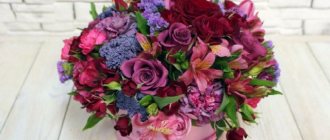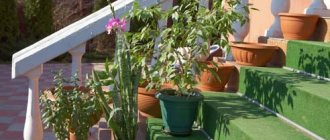Plants will bring a touch of freshness to the environment and ensure full compliance with fashionable trends - country, ethnic and eco-style. Some types of flowers are even recommended to be placed in the kitchen. They absorb carbon dioxide and other harmful compounds and release useful substances.
House flora may well be edible and used for cosmetic and health purposes.
According to Feng Shui, indoor plants represent the energy of wood, which is usually missing in modern kitchens.
It symbolizes new perspectives, growth, and if you place flowers in the eastern part of the room, it will improve family relationships. Certain plants are credited with magical properties - attracting money, romantic relationships, health. And many of them are great for the kitchen.
Main Determining Factors
When choosing plants, you need to take into account the climatic features of the room. The kitchen is characterized by dry hot air and temperature changes, which already introduces its own limitations. In addition, it is worth taking into account:
- 1. Amount and direction of sunlight. Some plants love direct sunlight (photophilous). There are also those that prefer to grow in the shade or in diffused light (shade-loving and shade-tolerant). And some look equally good both in the sun and in the shade, it’s just that their colors usually become brighter in the sun. Thick or light-diffusing curtains and phyto-lamps will help correct the current situation.
- 2. Minimum temperature in the room. When choosing indoor flowers for a summer or cold kitchen, pay attention to this indicator. Especially if in your case it drops below 15 degrees.
- 3. The presence of cold drafts, unacceptable for some flowers.
- 4. Features of the plant life cycle. Some species tend to rest in winter or even for the whole year. And this may mean that for some period the plant may not show any signs of life. And instead of lush vegetation, you will simply have a pot of soil standing on your window. This is how, for example, Zantedeschia or Oxalis behave. It turns out that it’s a pity to throw it away, and it seems to be alive, but somehow empty. Therefore, it is important that you are satisfied with the life cycle of the flower you like.
- 5. Difficulties in care. The need for regular spraying, special fertilizers, frequent replanting, changing the soil, replanting the plant - all this taken together makes flower care more difficult.
- 6. Presence of pets and children. Cat and dog lovers already understand what we're talking about. “But what does this have to do with children?” you ask. The fact is that many plants useful for the kitchen are poisonous (for example, aroids), and it is better not to taste them.
- 7. Tendency to allergies. Are you allergic? Then, you see, it’s better not to aggravate the situation. When a plant unknown to you has a pungent odor, opt for another one. Especially if the kitchen has poor ventilation or the windows are always closed.
Do you think this is all too complicated? That's why we have selected for you a list of the least picky indoor plants that will decorate your kitchen interior all year round.
Interesting ideas
When decorating a kitchen with flowers, you want to get a complete composition that organically complements the interior of the room. What do designers offer us?
For an interior designed in a minimalist style, with straight lines and subdued colors, choose the same plants. Aspidistra, dracaena, calathea, fatsia will ideally support the design of the room. Well-chosen flowerpots and pots will help enhance the effect of the presence of green beauties. Give preference to containers that match the color of the set or, conversely, choose bright pots that contrast with the general mood.
All types of hanging plants are suitable for a kitchen designed in a French, romantic style. Gracefully hanging from the walls, they will maintain the airy character of the room, complementing it with natural beauty. For such kitchens, buy ivy, pelley, fern, streptocarpus, nephrolepis.
For high-tech or techno, choose succulents. The original liptos, nicknamed "living stones", the humble aloe vera, "mother-in-law's tongue" and all kinds of cacti will look great against the backdrop of shining metal and glass.
Mini florarium is an excellent solution for the kitchen
In a rustic interior, geranium or violet will be a living addition. Traditional kitchen plants, they will unobtrusively support the comfort and warmth of the family hearth, pleasing the eye with bright colors.
In addition to combining with style, designers use plants to zone the kitchen space. This solution is especially relevant for large premises. By placing tall ficus, monstera, and bamboo on the floor, you can separate the dining area from the working area with a beautiful hedge. You can decorate both the table and the hanging shelves above it with flowers. In such a green corner, the dishes will be tastier and the communication will be more pleasant.
If the kitchen is equipped with a bar counter, try setting up a mini-florarium on it. This unusual technique involves placing plants in an aquarium. Round or rectangular, filled with gravel and plants, it will not take up much space and will easily turn into a stylish decorative element.
As you can see, despite the steam, heat and fumes, the kitchen is quite suitable for keeping plants. A competent choice of species, correct location and compliance with recommendations for caring for indoor flowers will allow you to create a small oasis of wildlife in the kitchen. Luxurious and modest, variegated and monochromatic, plants are sure to give a lot of positive emotions to both you and your household.
For a sunny kitchen
If your kitchen is flooded with bright sunlight every day, consider succulents and cacti. All of them will not be offended at all, and certainly will not disappear if you forget to water them.
Succulents
These plants have completely different origins, but they are all equally resistant to drought. They will tell you about overwatering - their fleshy leaves will begin to thin or wrinkle.
Soil: for succulents and cacti. Watering: in summer, succulents are watered no more than once every 1-2 weeks (or even less often), and in winter - even less often. Temperature: 7-35 degrees.
They are not afraid of drafts, they are hypoallergenic, mostly non-toxic and are unlikely to be of interest to pets - although anything can happen. There is no need to spray succulents, but you can periodically wash them from the shower with non-hot water, while avoiding waterlogging of the soil.
We will give just a couple of examples, but these characteristics apply to other succulents as well. And, believe me, there are a lot of them.
Aloe
There are more than 30 types of agave, differing in shape and color - for example, as in the photo. The older the aloe, the less often it needs to be watered.
It is very easy to care for: plant it in special soil for succulents and cacti, but it will just as well grow in soil dug up in the yard or park.
Aloe rarely blooms. Therefore, you can choose something different for the kitchen.
Kolanchoe
Flowering species - Kolanchoe Blossfeld, Mangus and Kalandiva need to be removed or covered from the sun after 3 o'clock in the afternoon. Less demanding in this case are the viviparous Kolanchoe - tubular-flowered, pinnate or Degremona.
The dissected-leaved kolanchoe or “deer antlers” also has an unusual appearance. Even on dimly lit windows it will delight you with bright yellow flowers.
cacti
Perhaps their only drawback is the thorns, which are sometimes poisonous. And in order to make a cactus bloom, you need to try to recreate their natural regime.
Soil: the ideal soil composition is soil from the park, fertilized with a small amount of coal, brick chips and sand, or a special soil mixture for cacti. Watering: a cactus will tolerate a lack of moisture more easily than an excess of moisture. In winter, watering is reduced to a minimum. Temperature: above zero.
Austrocylindroopuntia
This cactus... is quite edible. He loves daily evening watering and will hint to you if there is not enough water - he will shrink. All types of prickly pears need to be gradually accustomed to the changing seasons and gradually moved away from the cold window, as they do not tolerate sudden changes in light conditions. True, they do not die from this.
Cereus
This is both a real giant and a long-liver of the plant world. It is unpretentious, but it does not like stagnant air and gets sick from overwatering. It blooms beautifully and profusely, mainly at night.
Epiphyllum
The cactus family is not limited to round or long, spiny hedgehogs. But beauty requires sacrifice: the flower must be periodically sprayed, bathed and replanted annually.
Geraniums
A family of fragrant plants that seem to bloom every now and then.
Soil: suitable from the yard. Watering: 1-2 times a week, can be alternated with spraying. Temperature: above zero.
Disadvantage: Despite the fact that many plants in this family are medicinal, they can cause severe allergies. They smell specific.
Some plant species prefer bright, indirect light, such as through curtains.
Ficus benjamina
A bush that eventually turns into a tree.
Soil: for ficus. Watering: intensive in summer, moderate in winter. Lack of moisture will be indicated by dropping leaves. Temperature: 15-25 degrees.
Loves fresh air and regular spraying.
Crassula
She is also the money tree, the fat tree and the tree of happiness.
Soil: any. Watering: as the soil dries out - 1-2 times a week, in winter - less often. Sometimes you need to wipe or wash. Weak root system, so good weighted drainage is needed.
Temperature: from 6 to 25 degrees.
Delicious beauty
What do you think about growing edible crops? Plant parsley, onions, dill, arugula, basil or rosemary in your kitchen, and you will always have healthy seasonings at hand. An interesting solution would be beans - they bloom beautifully and climb like a vine.
Penumbra and shade
These are ideal conditions for a number of other plants. For the most part, they do not tolerate long-term exposure to direct sunlight.
Mulberries and aroids
We combined these different families because the care for them is almost the same.
The first includes ficus trees. Rubber-bearing, dwarf and lyre-shaped ficus are the most unpretentious. Periodically they need to be wiped and trimmed, forming a bush.
Among the aroids we can distinguish Dieffenbachia, spathiphyllum, scindapsus and anthurinum. The juice of most plants in this family is poisonous, but they also perfectly purify the air.
Soil: for ficus or from the park. Watering: as it dries out, 1-2 times a week. Temperature: 10-28 degrees.
Bamboo
Gets burned from direct sunlight.
Soil: can grow in a pot with stones and water, in soil from the yard, requires regular feeding with fertilizers. Watering: plentiful, as it dries out, in winter - rare. Temperature: 15-35 degrees.
Dracaena
Do you want a home palm tree? Here she is!
Soil: for palm trees or from the yard.
Watering: in winter – once a week, in summer – every 2 days.
It is recommended to spray dracaena every other day and place it in a bowl of water once a week.
Temperature: 13-26 degrees.
Requires regular feeding with fertilizers, but will survive without them.
Zygocactus
He is also a Decembrist, because this month it just begins to bloom.
Soil: not acidic. Watering: regular + spraying. Temperature: 15-26 degrees.
Needs fertilizer for flowering plants. When buds appear, the flower should not be rearranged.
Sansevieria
Among the people - mother-in-law's language. It blooms rarely, but when it does, it will surprise you with its fragrance.
Soil: for cacti or succulents, or mix equal parts leaf soil, turf soil and sand. Watering: rare, as the soil dries out. Temperature: 15-29 degrees.
Requires regular feeding with fertilizers for cacti and succulents or all-purpose fertilizers.
Ferns
They are also poisonous.
Soil: any. Watering: as it dries. Temperature: 7-25 degrees.
It is worth washing and spraying periodically.
Hedera
Ivy climbs and loves coolness, shade and humidity. Using multi-directional ropes, you can cover the window with a beautiful pattern.
Soil: any.
Watering: as it dries + regular spraying in dry air.
Temperature: 6-18 degrees.
Indifferent to conditions
These are universal soldiers who don’t care about anything.
Euphorbiaceae
They are diverse, original, and have medicinal properties. Most are poisonous, so they need to be replanted very carefully.
Soil: any.
Watering: as the soil dries.
Temperature: 6-21 degrees.
Herbaceous
A huge family, among which stand out:
- chlorophytum;
- Golden mustache;
- tradescantia;
- Cyperus;
- Oxalis (Oxalis).
Soil: any. Watering: as the soil dries + spray if desired. Temperature: 7-30.
Plants of this family, which resemble ordinary grass, attract domestic animals and are often harmed by them. In this case, it is better to exclude Cyperus, because its leaves are hard and sharp. The rest will not harm the pet.
Oxalis tends to rest in winter - during this time, simply move the empty pot from the window and water it 1-2 times a month.
Homemade vines in flowerpots
In country houses or loft interiors, where the beams are exposed, you can hang home vines directly on them. If there are no beams, you can hang flower pots on ceiling hooks. And if you don’t want to spoil the ceiling, then use special wooden platforms on the walls.
TIP: In rooms with low ceilings, hang the planter in a corner. This way it won't interfere.
Homemade vines in flowerpots example
Homemade vines in flowerpots
Homemade vines in flowerpots
Homemade vines in flower pots, example











